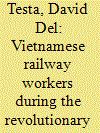| Srl | Item |
| 1 |
ID:
110216


|
|
|
|
|
| Publication |
2011.
|
| Summary/Abstract |
Over the years, Hanoi historians have presented different views of the role of communist organizers in the events of 1930-31. Thanks to the opening of the Comintern archives, we can now see that in 1929-30 there was a strong shift in international communism towards revolutionary violence in all parts of the world. This paper discusses the ideological precedents and influences reaching Vietnam from Russia and the Comintern, as well as from the Chinese revolutionary movement. These include the slogans and political analysis of colonial countries that the Comintern and its agents were popularizing in Moscow, Paris and China. They also include the experience of peasant revolt in southern China, in particular what became known as the Hai-lufeng Soviets in Guangdong province in 1927-28, as well as Chinese left-wing politics of 1928-30, when Li Lisan was a dominant force. The author explores the idea that violent anarchism, with roots in the theories of early Russian revolutionaries, may have been a link between these disparate influences. An examination of the attitudes expressed by different Vietnamese communist leaders towards the revolutionary violence of 1930-31 forms an important part of this paper. To what extent were they in tune with the Comintern? Did they find other sources of inspiration closer to home? Were they simply riding a wave of peasant anger? In conclusion, the author discusses conceptions of what the Revolutionary High Tide represented in terms of political change in Vietnam. Was it the coming of age of the proletariat; an expression of peasant grievances that got out of control; or a first step on the path to independence?
|
|
|
|
|
|
|
|
|
|
|
|
|
|
|
|
| 2 |
ID:
110220


|
|
|
|
|
| Publication |
2011.
|
| Summary/Abstract |
Vietnamese railway workers at the Truòng Thi workshops in colonial Vinh, north-central Vietnam did not join the uprisings against French authority that rocked Nghê An, Hà Tinh and Quang Ngãi provinces in 1930 and 1931. Although the railway workers by then shared a common vocational identity and were unified in seeking improvement of workplace concerns, ethnic, sectarian, regional and status differences among them weakened a common political identity. The heterogeneity of railway workers' attitudes towards political alignment at the time encourages a broader re-examination of the attitudes of participants and observers in the Nghê Tinh Soviets overall.
|
|
|
|
|
|
|
|
|
|
|
|
|
|
|
|